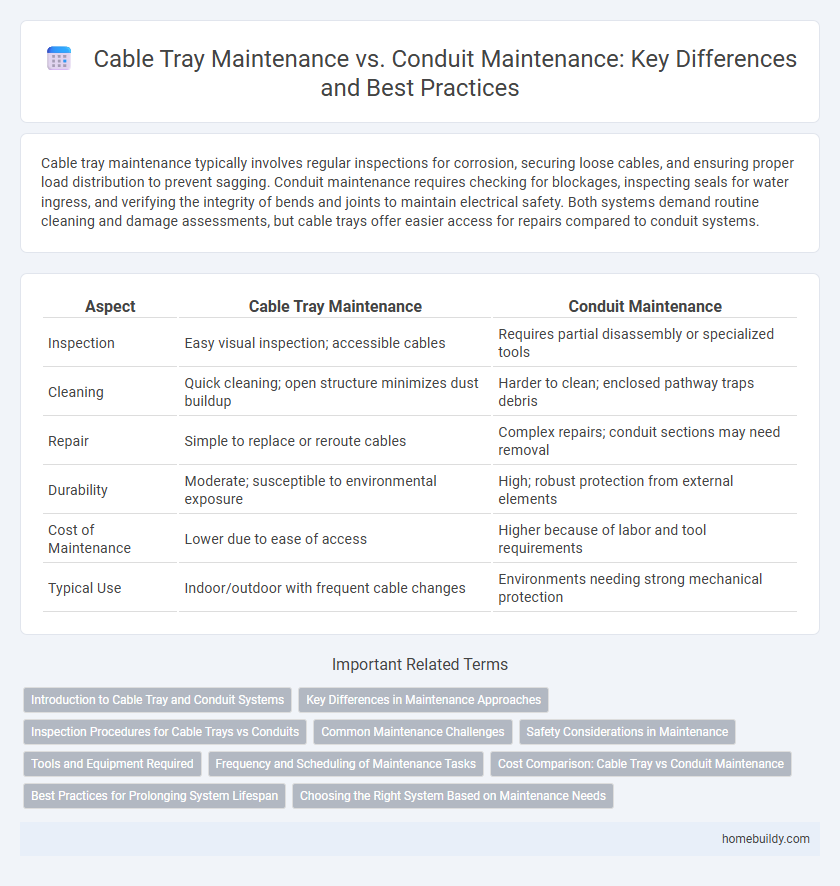Cable tray maintenance typically involves regular inspections for corrosion, securing loose cables, and ensuring proper load distribution to prevent sagging. Conduit maintenance requires checking for blockages, inspecting seals for water ingress, and verifying the integrity of bends and joints to maintain electrical safety. Both systems demand routine cleaning and damage assessments, but cable trays offer easier access for repairs compared to conduit systems.
Table of Comparison
| Aspect | Cable Tray Maintenance | Conduit Maintenance |
|---|---|---|
| Inspection | Easy visual inspection; accessible cables | Requires partial disassembly or specialized tools |
| Cleaning | Quick cleaning; open structure minimizes dust buildup | Harder to clean; enclosed pathway traps debris |
| Repair | Simple to replace or reroute cables | Complex repairs; conduit sections may need removal |
| Durability | Moderate; susceptible to environmental exposure | High; robust protection from external elements |
| Cost of Maintenance | Lower due to ease of access | Higher because of labor and tool requirements |
| Typical Use | Indoor/outdoor with frequent cable changes | Environments needing strong mechanical protection |
Introduction to Cable Tray and Conduit Systems
Cable trays provide organized support for electrical cables, offering easy access for inspection, maintenance, and future cable additions, which reduces downtime and labor costs compared to conduit systems. Conduit systems encase cables within rigid pipes, offering enhanced mechanical protection but complicating maintenance tasks due to limited accessibility and the need for conduit disassembly. Choosing between cable tray and conduit maintenance depends on factors like installation environment, ease of cable management, and long-term operational efficiency.
Key Differences in Maintenance Approaches
Cable tray maintenance primarily involves regular inspections to ensure load integrity, corrosion control, and securing cable support, while conduit maintenance centers on checking for blockages, physical damage, and moisture intrusion within enclosed pathways. Cable trays offer easier access for repairs and modifications compared to conduits, which often require dismantling for internal inspections and cable replacement. These distinctions emphasize that cable tray systems generally demand less invasive, more frequent visual checks, whereas conduit systems require more labor-intensive, periodic maintenance to prevent electrical faults and ensure safety compliance.
Inspection Procedures for Cable Trays vs Conduits
Inspection procedures for cable trays involve checking for physical damage, corrosion, loose fittings, and proper cable support to ensure structural integrity and prevent overheating. Conduit maintenance requires thorough inspection for cracks, moisture ingress, blockages, and secure connections to maintain electrical safety and prevent cable damage. Regular inspections in both systems help identify potential hazards and extend the lifespan of electrical installations in industrial and commercial settings.
Common Maintenance Challenges
Cable tray maintenance often involves addressing issues such as corrosion, physical damage, and accumulation of dust or debris, which can affect cable integrity and airflow. Conduit maintenance challenges typically include internal blockages, moisture ingress, and difficulty in inspecting hidden cables without disassembly. Both systems require regular inspection, but cable trays offer easier accessibility while conduits demand more labor-intensive maintenance due to enclosed spaces.
Safety Considerations in Maintenance
Cable tray maintenance enhances safety by providing easier access for inspections and repairs, reducing the risk of electrical hazards compared to conduit systems. Unlike conduits, cable trays allow for clear visibility of cables, facilitating early detection of damage, overheating, or wear while minimizing confined-space entry risks. Ensuring proper grounding and secure fastening in cable trays decreases potential electrical faults and fire hazards during routine maintenance activities.
Tools and Equipment Required
Cable tray maintenance requires basic tools like wrenches, screwdrivers, cable cutters, and inspection cameras to ensure proper cable management and structural integrity. Conduit maintenance often demands additional equipment such as fish tapes, conduit benders, and threading machines to navigate and modify enclosed conduit systems. Both methods prioritize safety gear, but conduit systems generally involve more specialized tools for installation and troubleshooting due to their enclosed nature.
Frequency and Scheduling of Maintenance Tasks
Cable tray maintenance typically requires less frequent inspection and cleaning compared to conduit maintenance due to its open design allowing easier access and visual checks. Conduit systems demand more regular maintenance schedules, often semi-annual, to prevent moisture buildup and ensure internal cable integrity. Proper scheduling of cable tray maintenance usually aligns with facility-wide electrical system reviews conducted annually, optimizing resource allocation and minimizing operational disruption.
Cost Comparison: Cable Tray vs Conduit Maintenance
Cable tray maintenance generally incurs lower labor costs compared to conduit maintenance due to easier accessibility for inspection and repairs. Cable trays allow quick modifications or replacements without extensive dismantling, reducing downtime and associated expenses. In contrast, conduit systems often require more complex disassembly, leading to higher maintenance costs and longer service interruptions.
Best Practices for Prolonging System Lifespan
Cable tray maintenance involves regular inspection for corrosion, debris removal, and ensuring secure fastenings, which prevents structural damage and electrical hazards. Conduit maintenance requires checking for cracks, moisture ingress, and integrity of joints to maintain effective cable protection and prevent system failures. Adopting scheduled cleaning, protective coatings, and prompt repairs significantly prolong the lifespan and reliability of both cable tray and conduit systems.
Choosing the Right System Based on Maintenance Needs
Cable tray systems require less frequent maintenance than conduit systems due to easier access for inspections and cable replacements, reducing labor costs and downtime. Unlike conduits, which often need dismantling to access internal cables, cable trays allow quick visual checks and modifications, making them ideal for dynamic environments with frequent cable upgrades. Selecting cable trays supports efficient maintenance strategies, particularly in industrial or commercial settings where operational continuity is critical.
Cable tray maintenance vs conduit maintenance Infographic

 homebuildy.com
homebuildy.com